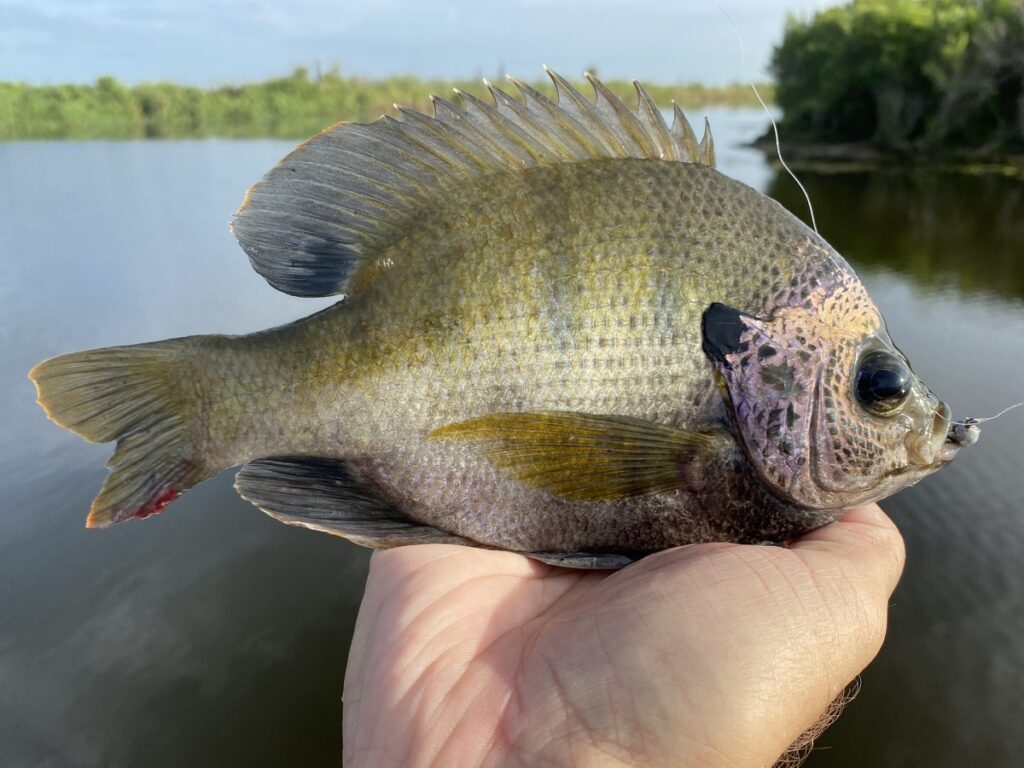The terms bluegill and brim are very common in the world of freshwater fishing… however, there is a lot of confusion around these terms.
Are bluegill and brim the same? What exactly do these terms mean and where do they come from?
In this article, I’m going to untangle the lines and tell you everything you need to know.
Table of Contents
Are Bluegill and Bream the Same?
In many parts of the southern United States, especially in the Southeast, any sunfish—including the bluegill—is colloquially called a “bream.”
However, this is somewhat of a misnomer. While bluegill is a specific type of sunfish, there are many other sunfish species that could technically be called bream in this context, such as longear sunfish, redear sunfish, and more.

In essence, while all bluegills are sunfish and could be referred to as bream in certain areas, not all breams are bluegills.
The use of the term “bream” to describe sunfish, or any small-sized panfish is just regional slang that might not be understood or accepted everywhere.
For example, if you are fishing on a lake in Tennessee, and run into a group of fellow anglers and ask “How’d yall do?” They might reply:
“We caught a mess of bream”.
This most likely includes a variety of panfish, like bluegill, longear sunfish, redear sunfish, and even hybrids.
So, to summarize: A bluegill is often referred to as a bream, and included in the ‘bream’ terminology, especially in North America. However, bluegill is a distinct species of fish. In other parts of the world, the term ‘bream’ most likely refers to any number of common bream species, which are part of the Abramidae family of fish, and unrelated to the bluegill.
Origins of the Names
Bluegill: The name “bluegill” is quite descriptive. These fish are characterized by a prominent blue or black “ear” (gill cover) and are part of the sunfish family. Scientifically, they are called Lepomis macrochirus.
Bream: Bream is a term with origins in the British Isles, where it’s commonly used to refer to several freshwater and marine species, notably those in the Abramidae family.
When European settlers came to the United States, they began to use the term more broadly, often referring to native sunfish as “bream.”
Reasons for the Confusion
- Regional Vernacular: As mentioned, regional differences in language have led to all sunfish being termed as bream in certain parts of the U.S., regardless of the specific species.
- Physical Similarities: Many sunfish species, including bluegill, share similar physical traits. They’re typically small to medium in size, have roughly circular, laterally compressed bodies, and exhibit a range of colors that often involve speckles, stripes, or spots. This similarity in appearance can lead to a generalization of the term “bream.”
- Angling Culture: Anglers often develop their own regional lexicons. Terms and names get passed down through generations and can vary widely from one place to another. In certain areas, particularly in the South, the tradition of calling sunfish “bream” has stuck.
Is Bream a specific type of fish?
“Bream” is a term that encompasses a variety of fish species. While many are genuine breams from the family Abramidae, others, due to regional vernaculars, have acquired the “bream” name.
Here are some of the different types of fish referred to as bream:
Genuine Breams (Family Abramidae)
- Common Bream (Abramis brama): A freshwater fish found in Europe and parts of Asia. It’s a popular fish among anglers in Europe.
- Silver Bream (Blicca bjoerkna): Smaller than the common bream and found in similar areas.
- White Bream or Zope (Ballerus sapa): Another freshwater species native to Europe.
- Roach-Bream Hybrid: A naturally occurring hybrid fish in European waters.
Australian Breams
- Black Bream (Acanthopagrus butcheri): A saltwater species native to Australia, it’s popular among recreational anglers.
- Yellowfin Bream (Acanthopagrus australis): Another saltwater bream species found in Australian waters, known for its distinctive yellow fins.
North American Fish Referred to as Bream
- Bluegill (Lepomis macrochirus): Common in the U.S., especially in the South, this sunfish species is sometimes referred to as “bream” or “brim.”
- Redear Sunfish (Lepomis microlophus): Also known as the “shellcracker bream” because of its fondness for snails and other mollusks.
- Longear Sunfish (Lepomis megalotis): Found mainly in the U.S., these colorful fish can also be called “bream.”
Asian Breams
- Japanese Sea Bream (Pagrus major): Known as “Tai” in Japan, it’s a valuable commercial fish and is often used in celebratory dishes.
- Black Sea Bream (Acanthopagrus schlegelii): Found in the northwestern Pacific.
South African Breams
- White Steenbras (Lithognathus lithognathus): A valuable sport and commercial fish species in South Africa.
See Also: What is the Difference Between Bream and Crappie
Is It Bream Or Brim Fish?
Bream and Brim are both accepted spelling variations of the word.
Summary
So, there ya have it…the term ‘bream’ is often used interchangeably with ‘sunfish’ and ‘bluegill’ in the southern United States, though it’s important to note that while all bluegills are sunfish and can be referred to as bream in certain areas, not all breams are bluegills.
This regional slang may not be understood or accepted everywhere, and in other parts of the world, ‘bream’ may refer to entirely different species of fish unrelated to bluegill altogether!
Don’t ya just love fisherman and their funny slang names? Thanks for reading!
